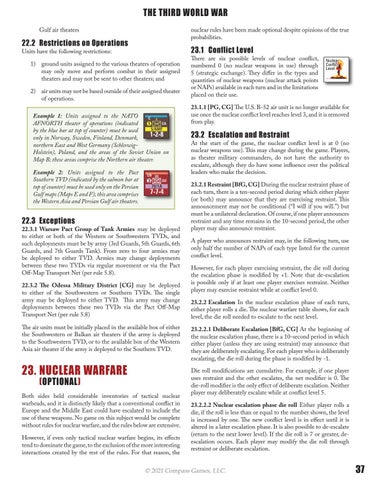THE THIRD WORLD WAR nuclear rules have been made optional despite opinions of the true probabilities.
Gulf air theaters
22.2 Restrictions on Operations
23.1 Conflict Level
Units have the following restrictions:
1) ground units assigned to the various theaters of operation may only move and perform combat in their assigned theaters and may not be sent to other theaters; and 2) air units may not be based outside of their assigned theater of operations. Example 1: Units assigned to the NATO AFNORTH theater of operations (indicated by the blue bar at top of counter) must be used only in Norway, Sweden, Finland, Denmark, northern East and West Germany (SchleswigHolstein), Poland, and the areas of the Soviet Union on Map B; these areas comprise the Northern air theater. Example 2: Units assigned to the Pact Southern TVD (indicated by the salmon bar at top of counter) must be used only on the Persian Gulf maps (Maps E and F); this area comprises the Western Asia and Persian Gulf air theaters.
22.3 Exceptions
22.3.1 Warsaw Pact Group of Tank Armies may be deployed to either or both of the Western or Southwestern TVDs, and such deployments must be by army (3rd Guards, 5th Guards, 6th Guards, and 7th Guards Tank). From zero to four armies may be deployed to either TVD. Armies may change deployments between these two TVDs via regular movement or via the Pact Off-Map Transport Net (per rule 5.8). 22.3.2 The Odessa Military District [CG] may be deployed to either of the Southwestern or Southern TVDs. The single army may be deployed to either TVD. This army may change deployments between these two TVDs via the Pact Off-Map Transport Net (per rule 5.8) The air units must be initially placed in the available box of either the Southwestern or Balkan air theaters if the army is deployed to the Southwestern TVD, or to the available box of the Western Asia air theater if the army is deployed to the Southern TVD.
23. NUCLEAR WARFARE (OPTIONAL)
Both sides held considerable inventories of tactical nuclear warheads, and it is distinctly likely that a conventional conflict in Europe and the Middle East could have escalated to include the use of these weapons. No game on this subject would be complete without rules for nuclear warfare, and the rules below are extensive. However, if even only tactical nuclear warfare begins, its effects tend to dominate the game, to the exclusion of the more interesting interactions created by the rest of the rules. For that reason, the
There are six possible levels of nuclear conflict, numbered 0 (no nuclear weapons in use) through 5 (strategic exchange). They differ in the types and quantities of nuclear weapons (nuclear attack points or NAPs) available in each turn and in the limitations placed on their use. 23.1.1 [PG, CG] The U.S. B-52 air unit is no longer available for use once the nuclear conflict level reaches level 3, and it is removed from play.
23.2 Escalation and Restraint
At the start of the game, the nuclear conflict level is at 0 (no nuclear weapons use). This may change during the game. Players, as theater military commanders, do not have the authority to escalate, although they do have some influence over the political leaders who make the decision. 23.2.1 Restraint [BfG, CG] During the nuclear restraint phase of each turn, there is a ten-second period during which either player (or both) may announce that they are exercising restraint. This announcement may not be conditional (“I will if you will.”) but must be a unilateral declaration. Of course, if one player announces restraint and any time remains in the 10-second period, the other player may also announce restraint. A player who announces restraint may, in the following turn, use only half the number of NAPs of each type listed for the current conflict level. However, for each player exercising restraint, the die roll during the escalation phase is modified by +1. Note that de-escalation is possible only if at least one player exercises restraint. Neither player may exercise restraint while at conflict level 0. 23.2.2 Escalation In the nuclear escalation phase of each turn, either player rolls a die. The nuclear warfare table shows, for each level, the die roll needed to escalate to the next level. 23.2.2.1 Deliberate Escalation [BfG, CG] At the beginning of the nuclear escalation phase, there is a 10-second period in which either player (unless they are using restraint) may announce that they are deliberately escalating. For each player who is deliberately escalating, the die roll during the phase is modified by -1. Die roll modifications are cumulative. For example, if one player uses restraint and the other escalates, the net modifier is 0. The die-roll modifier is the only effect of deliberate escalation. Neither player may deliberately escalate while at conflict level 5. 23.2.2.2 Nuclear escalation phase die roll Either player rolls a die, if the roll is less than or equal to the number shown, the level is increased by one. The new conflict level is in effect until it is altered in a later escalation phase. It is also possible to de-escalate (return to the next lower level). If the die roll is 7 or greater, deescalation occurs. Each player may modify the die roll through restraint or deliberate escalation.
© 2021 Compass Games, LLC.
37




